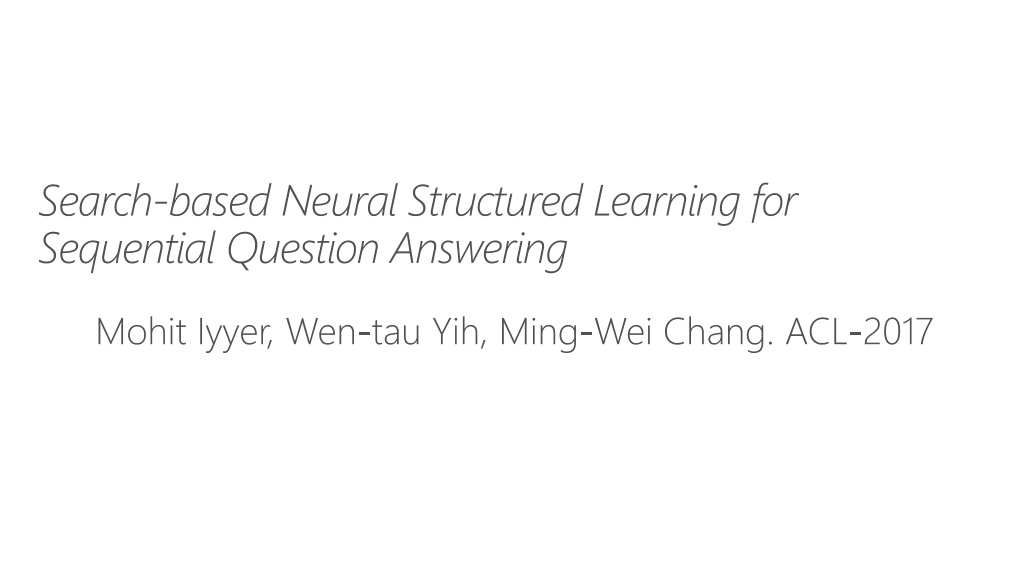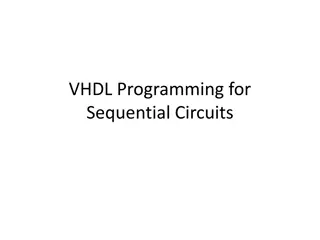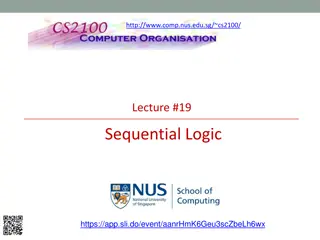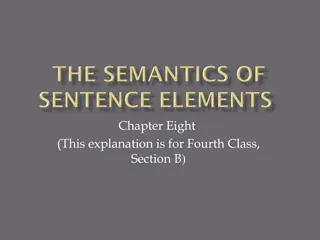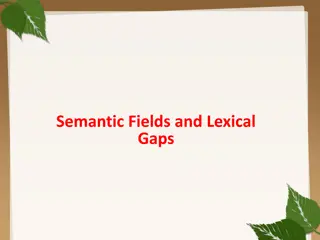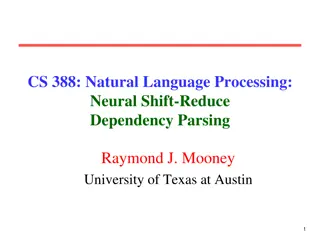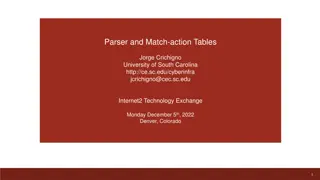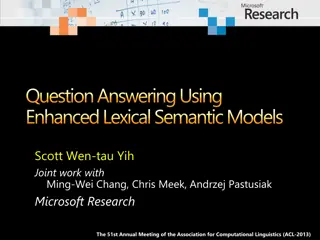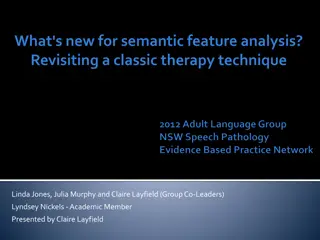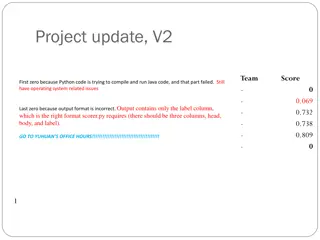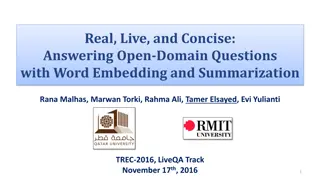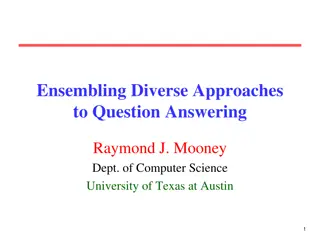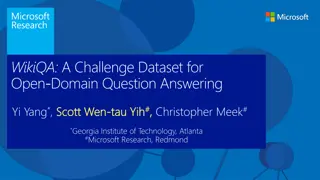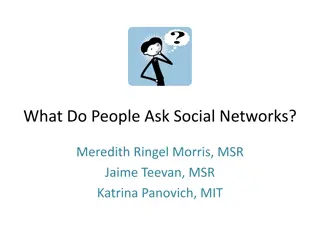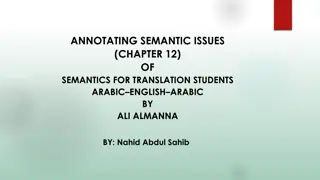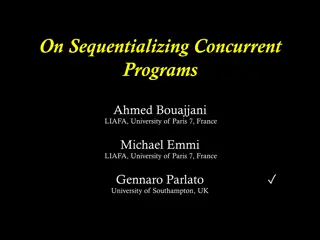Dynamic Semantic Parser Approach for Sequential Question Answering
Using a Dynamic Semantic Parser approach, the research focuses on Sequential Question Answering (SQA) by structuring queries based on semantic parses of tables as single-table databases. The goal is to generate structured queries for questions by defining formal query languages and actions for transition, aiming to find the best end state at runtime through reward-guided structured output learning. The SQA Dataset Creation process involves using WikiTableQuestions as a basis and encouraging simple questions with references. The approach aims to address challenging research problems in sequential question answering.
Download Presentation

Please find below an Image/Link to download the presentation.
The content on the website is provided AS IS for your information and personal use only. It may not be sold, licensed, or shared on other websites without obtaining consent from the author. Download presentation by click this link. If you encounter any issues during the download, it is possible that the publisher has removed the file from their server.
E N D
Presentation Transcript
Search-based Neural Structured Learning for Sequential Question Answering Mohit Iyyer, Wen-tau Yih, Ming-Wei Chang. ACL-2017
Answer Highly Compositional Questions What is the power of the super hero who is from the most common home world and appeared after 2010? Challenging research problem Advocated in semantic parsing [Pasupat & Liang 2015] But, a natural way to interact with a question answering system?
Answer Sequences of Simple Questions Who are the super heroes from Earth? Dragonwing and Harmonia Who appeared after 2010? Harmonia What is her power? Elemental
Our Task: Sequential Question Answering (SQA) MSR SQA Dataset (aka.ms/sqa) Sequences of questions, with annotated answers (coordinates)
SQA Dataset Creation (1/2) Start from WikiTableQuestions [Pasupat & Liang 2015] Use the same tables and same training/testing splits Find complicated questions in WikiTableQuestions as intents Intent Sequence of simple questions All answers to questions must be cells in the table Final answer must be same as that of the original intent Encourage simple questions and use of references
SQA Dataset Creation (2/2) Original Intent What super hero from Earth appeared most recently? Sequence of simple questions Who are all of the super heroes? Which of them came from Earth? Of those, who appeared most recently? Data statistics 2,022 intents 6,066 question sequences (3 annotators per intent) 17,533 total questions (~2.9 questions per sequence)
Approach: Dynamic Semantic Parser (DynSP) Semantic parsing Tables as independent single-table database Goal: Question Structured Query (semantic parse) Solution recipe Define the formal query (semantic parse) language Define the states/actions & action transition Run-time: search for the best end state Learning: reward-guided structured-output learning
Formal Query Language The formal query language is independent of data Preferably language used by external system (e.g., DBMS, APIs) A SQL-like language (select & conjunctions of conditions) Which super heroes came from Earth and first appeared after 2009? SELECT Character WHERE {Home World = Earth} {First Appeared > 2009}
States & Actions State: a (partial) semantic parse Action: add a primitive statement to a (partial) semantic parse Which super heroes came from Earth and first appeared after 2009? (1)select-column Character (2)cond-column Home World (3)op-equal Earth (4)cond-column First Appeared (5)op-gt 2009 ???(?): legitimate set of actions given a state For example, no select-column after select-column
Search Which super heroes came from Earth? (1)select-column (2)cond-column (3)op-equal Character Home World Earth Cond on Home World ?1 ?2 ?0 ?3 ?1 ?2 ?1 ?2 A state is essentially a sequence of actions The goodness of a state: V ?? = ? ?? 1 + ? ?? 1,??,? ?0 = 0
Neural Network Modules (1/2) Value of ? ?,? is determined by a neural-network model Actions of the same type (e.g., select-column) share the same neural-network module Which super heroes came from Earth? , ?1 ?2 ?3 ?2 ?3 Value = Earth Cond on Home World ?0 ?1 ?(?0,?1) ?(?1,?2) ?(?2,?3)
Neural Network Modules (2/2) Modules are selected dynamically as search progresses Similar to [Andreas et al. 2016], but structures are not pre-determined Network design reflects the semantics of the action Bi-LSTM Word Embedding character Word Embedding initialized with GloVe Q: Which super heroes came from Earth?
Reward-guided Structured Learning Indirect supervision: only answers are available Algorithm (for each question): Find the reference semantic parse that evaluates to the gold answers Find the predicted semantic parse based on the current model Derive loss by comparing them; update model parameters by stochastic gradient decent
Find the Reference Semantic Parse Ideal case: reference parse that evaluates to the gold answers True reward: ? = ? = ? (answers = gold answers) Beam search: find the parse with highest approximated reward Approximated reward: ? = ? ? ? / ? ? ? (Jaccard) ? = Which super heroes came from Earth? , ? = {Dragonwing, Harmonia} Cond on Home World ?1 ?2 ?0 ?3 ?1 ?2 ?1 ?2
Find the Predicted Semantic Parse Ideal case: every state ? satisfies the following constraint: ??? ??? ? ? ?(?) Beam search: find the most violated semantic parse ? = ? ? ? ? ??? + ??? (? : reference, ? ? ?(?): margin) ? = Which super heroes came from Earth? , ? = {Dragonwing, Harmonia} Cond on Home World ?1 ?2 ?0 ?3 ?1 ?2 ?1 ?2
Extension to Question Sequence For questions that are not the first in a sequence, allow a special subsequent statement Modules of subsequent conditions consider both previous and current questions Answers would be a subset of previous answers Which super heroes came from Earth? Which of them breathes fire? SUBSEQUENT WHERE {Powers = Fire breath}
Related Work Floating Parser (FP) [Pasupat & Liang. ACL-15] Map questions to logical forms Feature-rich system that aims to output the correct semantic parse Neural Programmer (NP) [Neelakantan et al. ICLR-17] Neural modules that are not tied to a specific formal language Output a probability distribution over table cells given a question Both FP & NP were designed for WikiTableQuestions Contains more long, complicated but independent questions
Results: Answer Accuracy (%) 50 44.7 45 40.2 40 33.2 35 30 25 20 12.8 15 11.8 7.7 10 5 0 All Sequence FP NP DynSP
Results: Answer Accuracy (%) 70.4 70 60.0 60 51.4 50 41.1 40 35.9 30 25.5 23.6 22.3 22.2 20 10 0 Position 1 Position 2 NP Position 3 FP DynSP
Reflections on DynSP An end-to-end joint learning framework Formulated as a state/action search problem Neural networks constructed dynamically as search progresses A first step towards Conversational QA Next steps Efficient training to test more expressive formal languages and neural network modules External data or interactive learning for better semantic matching
